How to Care for an Anthurium (Flamingo Flower or Flamingo Lily)

The flamingo flower (Anthurium) is a stunning tropical plant that you can easily grow indoors. Also called the flamingo lily, painter’s palette, laceleaf, little boy plant, and tailflower, anthurium plants are known for their spectacular shiny colorful spathes and spadices. With the proper care, anthuriums can flower throughout the year, adding a taste of the tropics to your interior. The bright red anthurium flowers are surrounded by glossy green heart-shaped leaves.
How to care for anthurium plants: To keep your flamingo flower healthy, place in bright, indirect sunlight and grow in acidic, well-draining soilless potting mix. Water flamingo plants when the top 1” (2.5 cm) of soil is dry, keep humidity high and grow in a temperature range of between 60°F and 90°F (16°C – 32°C). Feed the anthurium plant regularly from spring until the end of summer.
Anthurium plants are classed as an aroid in the plant family Araceae. They are native to the rainforests of South and Central America. Average household temperatures and humid conditions mimic their natural habitat.
The potted anthurium plant will grow to between 12 and 28 inches (30 – 70 cm) tall. All you need is to give this slow-growing tropical houseplant the care that it needs to thrive indoors.
Anthurium Flower
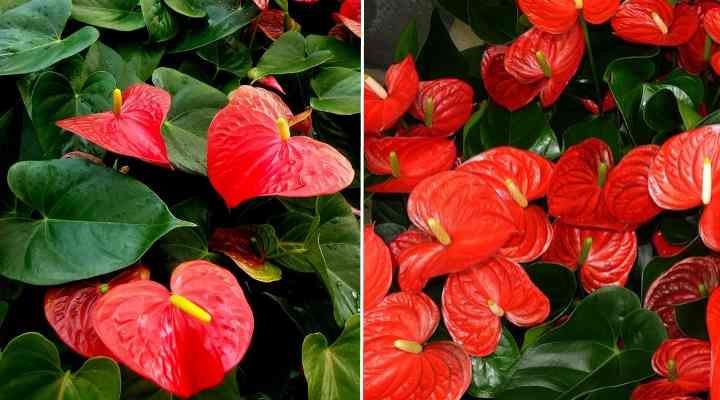
The flamingo ‘flowers’ are actually bracts which are modified leaves
Anthurium plants are often described as plants with red plastic looking flowers. The red heart-shaped flower is a modified leaf called a spathe or bract. What most people assume is the red waxy flower is not the plant’s flower.
The flamingo flower is the finger-like projection that grows at the base of the spathe. This small spike—called a spadix—is covered in tiny flowers that last a long time. This long-blooming time is one reason why anthurium flowers are popular in cut flower arrangements—they are one of the longest-lasting indoor cut flowers.
Under ideal conditions, anthurium plants can flower six times per year. The flamingo flower bloom should last for six to eight weeks. The best way to encourage your flamingo plant to flower is to mimic its ideal growing conditions in the rain forest.
Anthurium Species
The two most common anthurium species that are grown as houseplants are Anthurium andraeanum and Anthurium scherzerianum. The first variety has a straight flowering spike (spadix) with heart shaped bract (modified leaf that looks like a flower) and foliage. The bract can be red, pink or orange. The second type has curled flower spike with ovoid red bract and elongated leaves.
Different species of anthuriums have different shaped flowers. The most common types of anthuriums—Anthurium andraeanum and Anthurium scherzerianum—have spiked-shaped flowers. Other kinds of anthuriums have flowers resembling small globes or clubs.
There are also many anthurium cultivars with flowers in different colors. The most common is the waxy red flower with a yellow spadix. Other colors of flowers include purple, light pink, orange, white, and variegated varieties. There is also one of the coolest looking houseplants plants you will find—a black anthurium.
In this article, you will find the best care advice for growing anthurium plants indoors. You will learn how to make the flamingo flower grow faster and how to resolve any growing issues with it.
How to Care for Anthurium (Flamingo Flower)
Anthurium plants are tropical plants that grow well indoors. Although they are not too picky when it comes to their conditions, there are some essential tips to help the plant flourish and bloom regularly.
Light Requirements for Anthurium
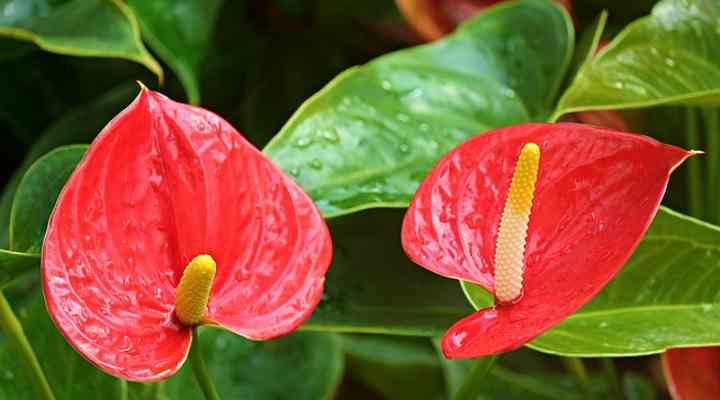
In the picture: Anthurium andraeanum with straight flowering spike (spadix) and heart shaped red bract and green foliage
Being a plant native to rainforests, flamingo flower plants need to grow in moderate to bright light. The essential care requirement is to protect the plant’s glossy foliage from direct sunlight. Place your flamingo lily near an east-facing window where it gets some morning sun. Don’t put it on a south- or west-facing windowsill where it could be sunburned.
Anthurium plants are not low-light plants. If the light isn’t adequate, they become leggy and straggly. Low light also causes anthurium growth to slow down and fail to bloom throughout the year. So, the best solution to speed up growth and encourage the colorful flowers to appear is to put it in a bright location.
You can also grow anthurium flowers outdoors if you live in USDA zones 10 through 12. Similar to growing indoors, they need to be planted in an area of your yard that is partly shaded or has filtered indirect light.
How to Water Anthurium (Flamingo Lily)

This image shows Anthurium scherzerianum with curled flower spike with ovoid red bract and elongated leaves
Proper watering is one of the most important care requirements when growing flamingo plants indoors. You only need to water anthuriums as often as the potting mix partially dries out. Generally, in summer you should water the flamingo flower more often than in winter. Overwatering causes root rot and results in yellow leaves and wilting growth.
The best way to water anthurium is to give the potting mix a thorough drenching. Pour in enough water until it drains out the pot’s drainage holes. Watering in this way ensures the roots get hydrated and nourished. Allow all the water to drain before placing the tropical flowering plant back in a bright location.
How do you know when to water your beautiful flamingo flower? Firmly press on the potting medium to check for moisture. If the top 1” to 2” is completely dry, it’s time to hydrate your plant. If there is still moisture in the soil, wait a few days until the top part of the soil has dried out.
During the growing season from early spring until early fall, you will probably water your anthurium as often as once or twice a week. During winter, you will need to water the plant less frequently. However, always let the soil determine when to water your flamingo plant.
A common mistake to avoid when watering anthuriums—or any other indoor plant—is to water often and a little. This type of watering can cause your anthurium plant to show signs of underwatering—brown tips on the leaves. The reason is that moisture doesn’t seep through to the roots. When it’s time to water your tropical plant, water thoroughly and deeply.
Problems with watering are often the root cause of growing issues and mold that affect anthuriums. Only water as often as the flamingo plant needs it—when the soil has partially dried out.
The Best Soil to Grow Flamingo Flowers
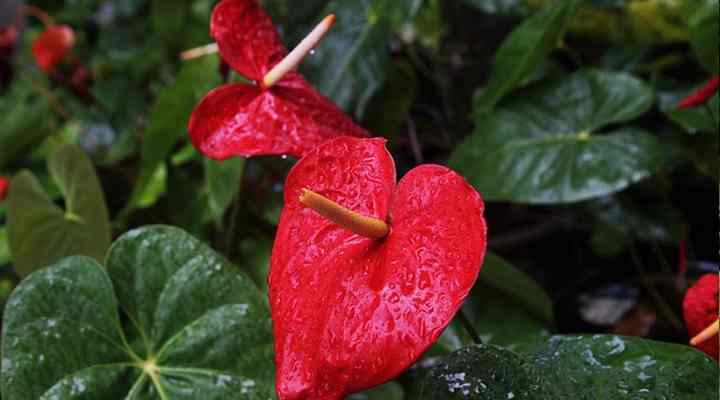
The Anthurium andraeanum is also called the oilcloth plant as its bract looks like a red waxy plastic-like flower
Anthurium plants need to grow in an aerated potting soil that has excellent drainage, yet holds some moisture. Fertile, acidic soil that is porous—such as for orchids—is ideal. You can create your own potting medium by mixing peat moss, cactus mix, and coco coir.
Anthuriums are a type of epiphyte that has aerial roots. So, they don’t need to root in the soil, but they absorb nutrients and moisture through their roots. In milder climates, anthuriums grow better in organically-rich, coarse potting soil. It’s crucial to avoid heavy potting soil as this holds too much moisture and causes root rot and may kill the plant.
To check if the soil is of the right consistency, water should drain quickly through the potting mix. Water pooling on the soil surface is a sign that you need to improve the growing medium.
Ingredients you can add to potting soil to make it suitable for laceleaf plants include:
- Crushed charcoal
- Bark chipping
- Coarse sand
- Sphagnum moss
- Orchid bark
- Coco coir
Temperature Requirements to Grow Flamingo Flowers
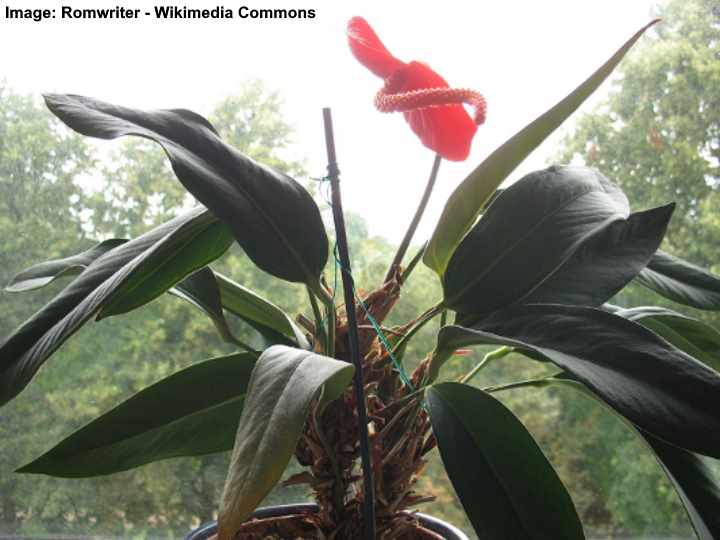
Anthurium scherzerianum (flamingo plant) bract can be pink, red or orange colored
Average room temperatures are ideal for growing painter’s palette plants. Anthuriums grow faster in warmer temperatures. Although these tropical plants grow in temperatures above 60°F (15°C), the optimal temperature range is 70°F to 86°F (21°C – 32°C). Flamingo flowers prefer a steady temperature; so, keep away from cold drafts or hot radiators.
You can take potted flamingo plants outdoors during the summer if the temperature is warm. Place the plant in partly shaded area where it doesn’t drop below 60°F (15°C). When the nighttime temperatures start dipping toward 50°F (10°C), take the plant back inside. Low temperatures can cause growth to slow down and could even kill the plant.
If you want to encourage regular blooming, make sure that the anthurium plants are in warm temperatures, bright indirect light, and get enough humidity. Your care for these stunning plants will be rewarded with beautiful red flowers.
Humidity Requirements for Anthuriums
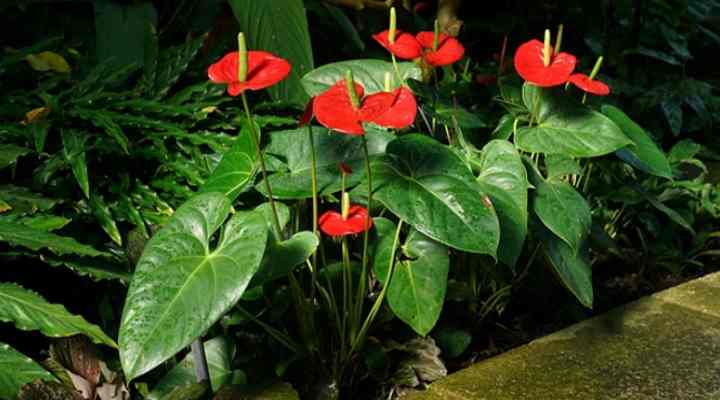
Proper anthurium care requires high humidity levels of at least 80%
Flamingo lilies need high humidity—similar to their native habitat of Colombia and Ecuador. Ideally, flamingo flowers thrive in at least 80 percent humidity. To increase humidity, mist the leaves daily, use a humidifier, or place the plant pot on a pebble tray. Humid conditions help the plant absorb moisture and grow healthily.
The typically dry household air can make growing anthuriums indoors challenging. For example, heating systems tend to dry out the air. Or, a lack of air circulation can also affect tropical houseplant growth.
Here are a few easy ways to meet the flamingo’s plants humidity needs:
- Mist the leaves daily—Fill a spray bottle with distilled or filtered water. Leave it out until it reaches room temperature. Spray a fine mist over the top of the plant’s leaves.
- Humidify with a pebble tray—Put a layer of small pebbles or stones in a deep tray. Pour water in the tray until it reaches half-way up the stones. Place the flamingo plant pot on the pebbles.
- Use a room humidifier—If you have several tropical houseplants, investing in a humidifier can help create the ideal tropical indoor environment.
You can also place your flamingo lily in a well-lit bathroom. Bathrooms with windows tend to have frosted glass—so, that protects the anthurium from the sun’s direct rays. Also, the steam from the shower creates a humid atmosphere for your flamingo plant to thrive.
Please read this article to find out more about other types of shower plants.
How to Propagate Anthurium Plants
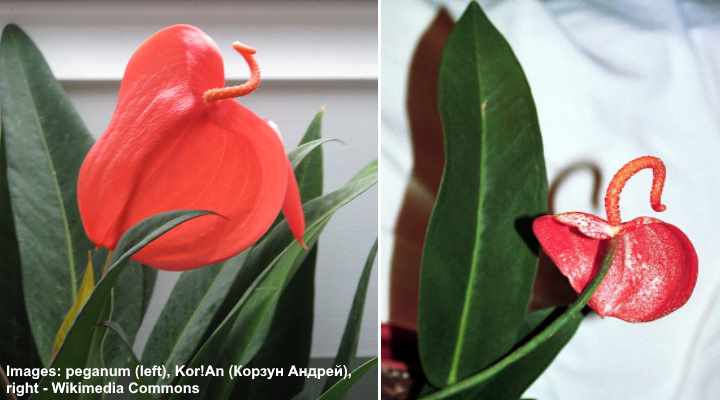
In the picture: Anthurium scherzerianum with curled spike (spadix) and red bract
The easiest way to propagate flamingo flowers is by root division or stem cuttings in the springtime. Propagating an anthurium plant helps to manage its size, and you can also gift this beautiful tropical houseplant. The red, heart-shaped waxy leaves mean that it’s a popular gift to symbolize love, romance, and dedication.
To propagate a flamingo plant by root division: Gently remove the plant from its container and shake the excess dirt free. Carefully separate the root mass into two or three sections, making sure that there are at least two leaves on each. Replant in new pots.
To propagate flamingo plants by stem cuttings: Cut off one healthy stem that is at least 6” (15 cm) long and has two or three leaves on it. Fill a terracotta pot three-quarters full with an appropriate potting mix that drains well. Make a hole in the center, and plant the stem cutting 3” (7.5 cm) deep. Thoroughly water the plant and place it in a bright location where there’s high humidity. After about four to six weeks, the plant should be rooted.
When to Repot Flamingo Plants (Anthurium)
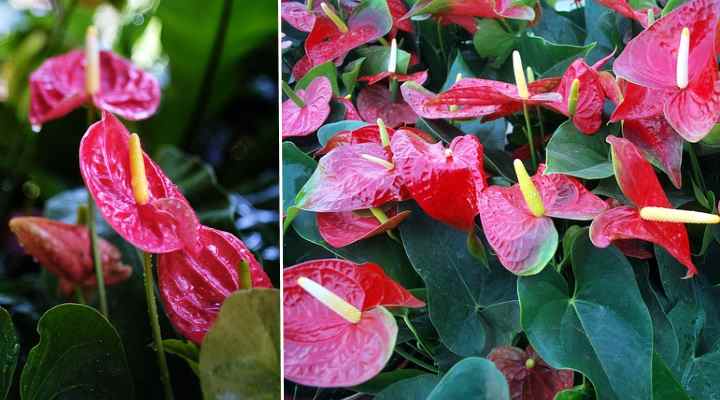
To encourage a healthy growth of your anthurium plant, repot it every 2-3 years
Repot anthurium plants every two to three years in spring to prevent them from becoming rootbound. Transferring your flamingo plant to a larger pot allows the roots more room to grow. You will need to repot flamingo plants when roots poke out the bottom or water doesn’t drain as quickly. You can also refresh the potting soil at the same time.
To repot an anthurium plant, gently ease it from its current container. Remove excess soil and carefully untangle the roots. Check the roots to make sure they’re healthy—snip off any brown, mushy ones. Place the plant in a new, slightly larger pot, making sure it’s growing at the same height. Press around the stems to firm up the soil. Thoroughly water the plant.
As a general rule, choose a new container that is the next size up. The pot should have drainage holes to prevent the soil from becoming waterlogged. Avoid repotting in a pot that is too large. The extra soil takes longer to dry out, and you will get problems with rotting roots and fungal issues.
How to Prune Flamingo Plants
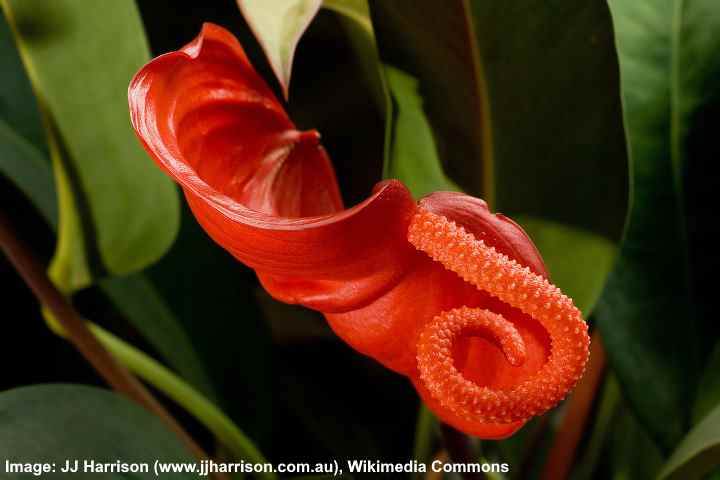
Anthurium scherzerianum
Anthurium plants don’t require any special pruning to encourage faster growth. The plant has slow to medium growth when in optimal conditions. The only time you need to prune flamingo flowers is to remove dead foliage and trim off spent flowers. Always remember to use sterilized pruning shears to prevent transferring any disease.
You can also look after the shiny, glossy anthurium leaves by wiping them down regularly. Removing dust will help the waxy leaves retain their sheen and keep your plant looking healthy.
Anthurium Fertilizer
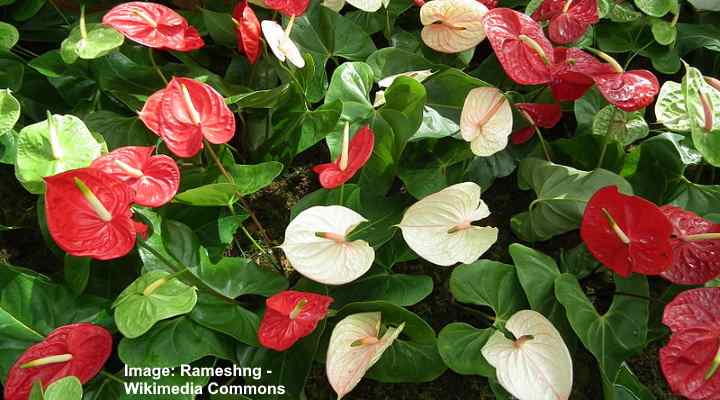
Anthuriums with red and white bracts – fertilize your anthurium plant every six to eight weeks to encourage faster growth rate and flowering.
Flamingo lilies benefit from fertilizing every six to eight weeks. The best kind of fertilizer for flamingo plants is one that is high in phosphorus. This mineral helps promote regular blooming throughout the growing season. Dilute the fertilizer to half strength and apply every other month when watering the Anthurium plant.
Feed the flamingo flower plant regularly from spring until the end of summer. Don’t fertilize during winter, or you could risk killing your plant from a mineral buildup.
Another way to prevent a mineral buildup is to flush the soil two or three times during the growing season. Slowly pour water through the potting mix for a few minutes. Allow to drain and then resume watering when the top 1” (2.5 cm) of soil has dried out.
Pest and Diseases Affecting Anthurium
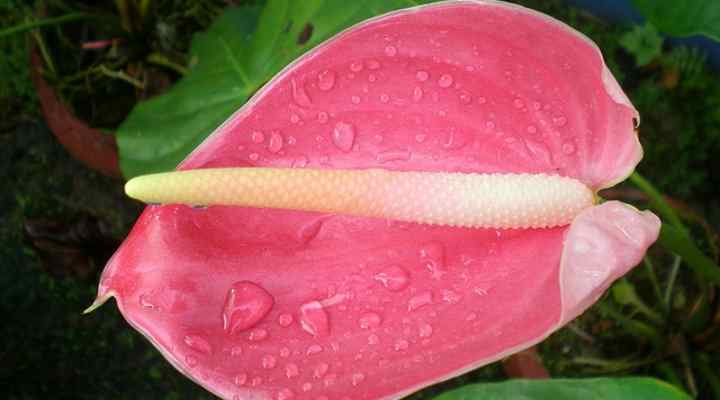
Pink anthurium bract with creamy-yellow spadix
The most common pests to affect flamingo flowers are mealybugs, spider mites, and aphids. These houseplant pests can suck the life out of your plant, causing it to die. With the right care, some types of pests and diseases can be easily avoided. If you spot signs of houseplant pests, it’s essential to act quickly.
For example, overwatering anthurium plants can lead to fungal and bacterial root diseases. Also, mealybugs tend to thrive in damp environments. So, by watering only as often as you need to, you can prevent some pest and disease issues. Fungus gnats and white mold are also common—but less deadly—issues in damp conditions.
Underwatering can also lead to problems with spider mites. These are tiny pests that leave webs under the plant leaves and on stems. Watering whenever the top part of the soil is dry, but the lower part is moist can help prevent spider mites. Also, regular misting will help to prevent these pests from killing your plant.
Please read our article to find out how to kill common indoor plant pests naturally.
Is Anthurium Poisonous?
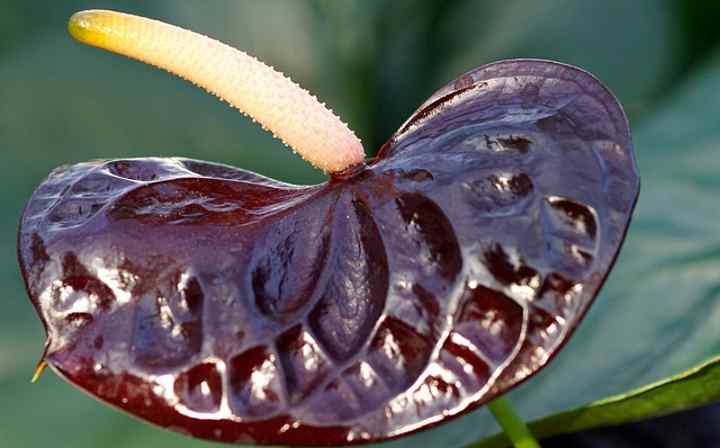
Deep purple, almost black anthurium bract with white-yellow spadix
Yes, anthurium plants contain insoluble calcium oxalates that are harmful to pets and humans. The American Society for the Prevention of Cruelty to Animals (ASPCA) says that flamingo flowers are toxic to cats, dogs, and horses. Signs of poisoning are drooling, vomiting, and swelling of the oral cavity. (1)
FAQ on Caring for Anthurium Plants
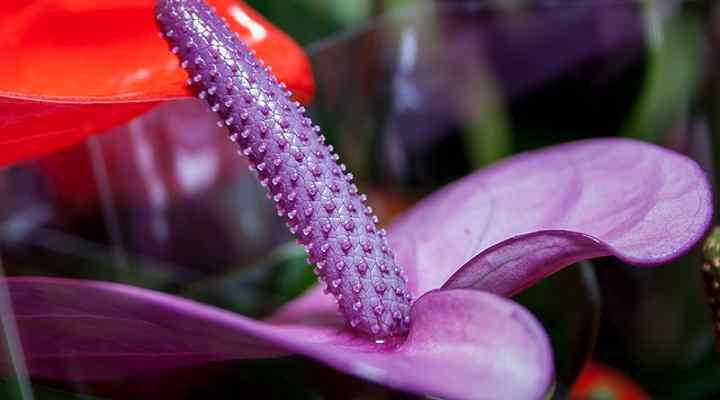
Purple anthurium bract and spadix
Do Anthuriums flower every year?
Flamingo plants are perennial evergreen plants that bloom throughout the year. Under ideal conditions, the plant flowers for between six and seven weeks. If you get the growing conditions right indoors, you may have flowers that last from winter until the middle of summer and even longer. Deadhead the flower stems when the flowers start turning green.
How to get an Anthurium plant to bloom?
To make sure that flamingo plant flowers, you need to get the conditions right. Although these tropical plants can grow in low-light conditions and cool temperatures, they won’t bloom.
To make sure your anthurium plants produce flowers regularly, you should water them appropriately, place in a bright location, keep humidity high, and feed with a fertilizer high in phosphorus. This way, you are sure of getting many red waxy flowers throughout the year.
How big do Anthuriums grow?
As an ornamental houseplant, flamingo flowers grow to between 12” and 30” (30 – 76 cm) high. Under ideal conditions, your indoor plant may even reach 3 ft. (90 cm) high and have a bushy appearance with glossy green foliage.
How long do Anthurium plants live?
If you care for them properly, flamingo plants will bloom year on year for many years.
Why do anthurium plant leaves turn yellow?
The most common reason why flamingo green waxy leaves turn yellow is overwatering. If you notice that a few leaves have started to turn yellow, check the soil for dampness. If the top of the soil is overly damp, don’t water the plant until at least 2” (5 cm) of soil is dry.
Learn about many other beautiful types of anthurium plants (including pictures and care guide).
Related articles:
